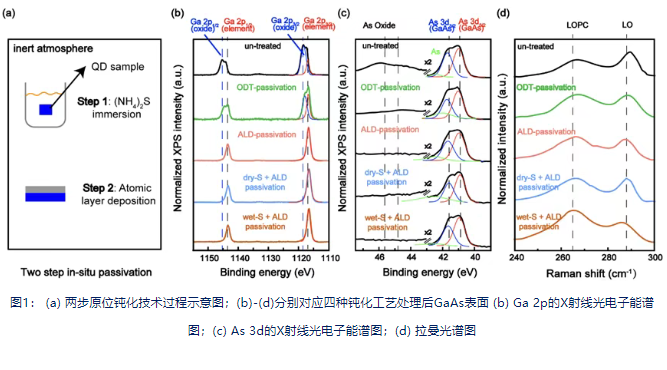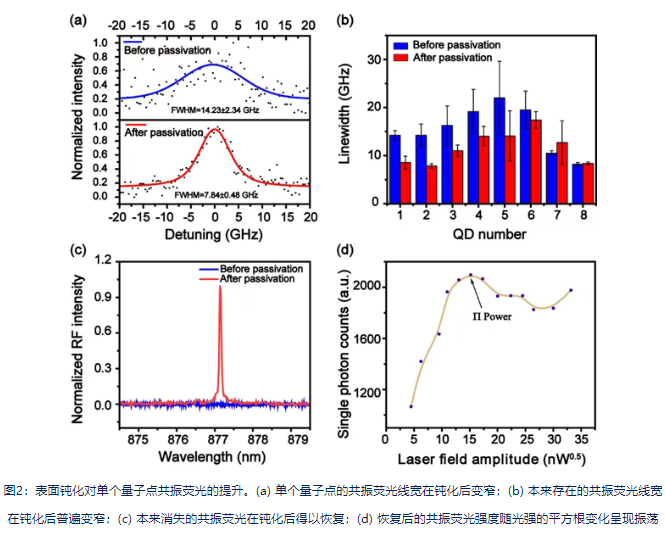02
2025
-
06
Surface passivation enhances the resonant fluorescence of quantum dots
Author:
Recently, Pan Jianwei, Huo Yongheng, Lu Chaoyang, and others from the University of Science and Technology of China have made significant progress in the surface passivation of quantum dots. Researchers have proposed a passivation technique that successfully reduces the influence of surface states and achieves an improvement in the quality of near-surface quantum dot resonance fluorescence. This work innovates the process, device structure, and characterization methods, and is expected to provide strong technical support for the further development of deterministic quantum light sources.
The results are published in Deterministic resonance fluorescence improvement of single quantum dots by optimized surface passivation under the title 'Light: Science & Applications' The corresponding authors of the paper are Professor Huo Yongheng and Professor He Yuming from the University of Science and Technology of China 霍永恒教授、何玉明教授 Zhao Junyi, a doctoral student at the University of Science and Technology of China 博士研究生赵军一 is the first author of the paper.
Solid-state semiconductor quantum dots, as ideal carriers of deterministic quantum light sources, have become important devices in the field of photonic quantum information technology due to their excellent optical properties. With the continuous improvement of device integration, the overall structure becomes more compact, reducing transmission loss and enhancing coupling efficiency, while also significantly enhancing the interaction between quantum dots and the surface. Specifically: intrinsic surface states caused by semiconductor lattice interruption, and additional surface states introduced by surface oxidation and micro-nano processing, will all affect the optical and electrical properties of the device. For example, the distance between quantum dots coupled to photonic crystal microcavities or bullseye cavities and the surface is about 50 nm. At this distance, the fluorescence quality of quantum dots will be deteriorated by the influence of surface states, resulting in linewidth broadening, reduced brightness, or even fluorescence disappearance.
To address this bottleneck, researchers have put on a layer of "atomic-level protective clothing" for quantum dots, that is, introducing surface passivation technology to protect quantum dots and improve their fluorescence quality.
Through various wet and dry passivation techniques such as chemical solution treatment and atomic layer deposition (ALD), many domestic and foreign related studies have achieved a significant improvement in the non-resonant fluorescence of near-surface quantum dot ensembles. However, considering that in practical applications of quantum information, single quantum dots need to be manipulated through resonant excitation, a comprehensive study of the improvement of the resonant fluorescence performance of single quantum dots is more meaningful. Therefore, it is necessary to conduct in-depth research on the surface passivation technology of near-surface quantum dots.
In response to the above needs, this paper proposes a two-step in-situ passivation technique (wet-S+ALD passivation): as Figure 1 (a) shows, the quantum dot device is passivated with ammonium sulfide solution in a glove box filled with inert gas, and then transferred in situ to an atomic layer deposition system for film deposition, further maintaining the passivation effect. To demonstrate the advantages of this technique, it is also compared with ODT solution passivation (ODT-passivation) and ALD film deposition (ALD-passivation). X-ray photoelectron spectroscopy and Raman spectroscopy test results confirm that the passivation scheme used in this paper has a better surface passivation effect ( Figure 1 (b)-(d) ).

In this paper, a point-to-point method is used to measure the changes in the resonant fluorescence of single quantum dots before and after passivation. The results show that the resonant fluorescence shows a significant improvement from "nothing to something, and from something to better" after passivation. This paper first studied 8 quantum dots that already had resonant fluorescence signals before passivation. As Figure 2 (a) shows, the resonant fluorescence linewidth of the quantum dots before passivation is 14.23±2.34 GHz, which narrows to 7.84±0.48 GHz after passivation, and the contrast of the signal to the background is also significantly improved. From Figure 2 (b) it can be seen that the resonant fluorescence linewidth of most quantum dots is generally narrowed after passivation. At the same time, this paper also measured 5 quantum dots that did not have resonant fluorescence before passivation. The results show that 2 quantum dots were "revived" after passivation, and the resonant fluorescence that could not be measured before was restored, and 2π Rabi oscillation could be observed. This paper also theoretically analyzes the improvement mechanism, and the results are consistent with the experimental trend.

In summary, the passivation technology used in this paper shows a better passivation effect compared with other reported experimental results, and the resonant fluorescence of near-surface quantum dots has achieved a performance improvement from "nothing to something, and from something to better". This passivation technology and experimental ideas are expected to be applied in various solid-state quantum devices, and provide strong technical support for the further development of integrated quantum chips.
LATEST NEWS
2025-06-06
Photonic avalanche nanocrystals with >500-order optical nonlinear response
At the forefront of nonlinear optical materials research, photon avalanche (PA), a unique luminescence mechanism occurring in lanthanide-ion-doped systems, exhibits exponential response under continuous laser pumping through an energy positive feedback loop mechanism, thus demonstrating ultra-high-order nonlinear optical behavior far exceeding traditional upconversion processes.
2025-06-05
Ji Xingchen/Su Yikai LPR | 780 nm on-chip integrated high-Q ultra-wideband Fabry-Perot cavity
With the rapid development of applications such as quantum precision measurement, atom manipulation, and narrow linewidth lasers, higher and higher demands are placed on high-performance photonic devices operating in the visible and near-visible wavelength range (especially the 780 nm wavelength corresponding to the rubidium atomic transition).
2025-06-23
Binary optics and metasurface lenses
Bichromatic optics is a subject or an optical technology; the concept of a meta-lens is more inclined to be a device.
2025-06-23
Achromatic diffractive waveguide in AR glasses
AR glasses seem to have developed rapidly in recent years; many believe this is the device most likely to replace mobile phones in the future.

